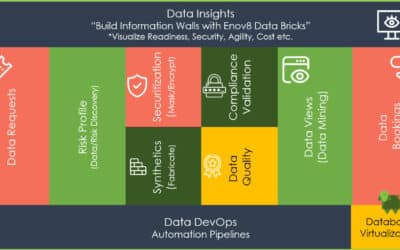
Creating a Test Environment Management Tool Scorecard for RFPs
APR, 2023
by Jane Temov.
Jane Temov is an IT Environments Evangelist at Enov8, specializing in IT and Test Environment Management, Test Data Management, Data Security, Disaster Recovery, Release Management, Service Resilience, Configuration Management, DevOps, and Infrastructure/Cloud Migration. Jane is passionate about helping organizations optimize their IT environments for maximum efficiency.
1. Introduction
When selecting a IT & Test Environment Management (TEM) tool, it can be overwhelming to evaluate the many available options. A TEM tool scorecard is a helpful tool to objectively evaluate the different vendors and their offerings. A scorecard can provide a standardized framework to assess each vendor’s capabilities against your organization’s specific needs. This section will provide an overview of what a TEM tool scorecard is, why it is important to use one, and the purpose of this post.
Enov8 IT & Test Environment Manager
*Innovate with Enov8
Streamlining delivery through effective transparency & control of your IT & Test Environments.
A TEM tool scorecard is a tool that enables an organization to compare different TEM tools based on specific evaluation criteria. The scorecard can be customized based on the organization’s unique requirements and priorities. Using a scorecard can help ensure that all vendors are evaluated consistently, which is important in making informed decisions.
Using a scorecard is especially important when evaluating TEM vendors as there are many vendors and offerings to choose from. Each vendor may have a unique set of capabilities, and it can be challenging to determine which capabilities are essential for your organization. By using a scorecard, you can establish clear criteria for evaluating vendors and identify which vendor is the best fit for your organization.
The purpose of this post is to provide guidance on creating a TEM tool scorecard for RFPs. This post will outline the key evaluation criteria to include in the scorecard, explain the scoring and weighting systems, provide a sample scorecard, and offer tips for using the scorecard effectively. By the end of this post, you should have a better understanding of how to create a TEM tool scorecard that will help you choose the best TEM vendor for your organization.
2 Key Evaluation Criteria
To create a comprehensive TEM tool scorecard for test environments, it is important to identify the key evaluation criteria. These criteria should reflect the specific needs and priorities of your organization. While each organization may have different requirements, some key evaluation criteria to consider when evaluating TEM vendors for test environments include:
2.1. Flexible Hosting:
- Ability to deploy the tool on-premises, in the cloud, or in a hybrid environment
- Support for various cloud platforms, such as AWS, Azure, and Google Cloud
- Ability to easily switch between hosting environments as needed
2.2. Environment Blueprinting:
- Ability to quickly add or discover IT Environment information
- Ability to easily map, model and classify IT environments, Systems, Instances, Components and IT Services
- Integration with other “Sources of Truth” like CMDBs
2.3. Environment Planning & Coordination:
- Ability to plan, schedule and manage environment usage
- Coordination and communication with stakeholders including developers, testers, and project managers
2.4. Demand Management:
- Ability to manage and prioritize requests for test environments
- Support for booking management, with the ability to view availability and schedule requests
2.5. Service Management:
- Capability to manage service requests, incidents, and changes
- Integration with popular IT Service Management (ITSM) tools such as ServiceNow, Jira Service Desk, and Zendesk
2.6. Operational Baselining:
- Ability to baseline the current state of test environments and establish best practices
- Documentation of standard operating procedures (SOPs) for environment management
2.7. Environment Automation:
- Support for IT environment automation across different platforms, such as Linux, Windows, Mainframe, and database
- Integration with popular infrastructure tools such as Ansible, Puppet, and Chef to automate the deployment and configuration of environments
- Integration with popular application tools such as Jenkins, Bamboo, and TeamCity
2.8. Environment Health Monitoring:
- Ability to monitor environment health and performance
- Alerting and notification capabilities to ensure that issues are addressed in a timely manner
- Ease of integration with existing Monitoring solutions like Zabbix, Nagio, AppDynamics & Dynatrace.
2.9 Test Data Management:
- Evaluates the TEM tool’s ability to manage test data effectively.
- Considers the tool’s data risk profiling capabilities to identify and mitigate risks associated with sensitive data.
- Assesses the tool’s data masking features to hide sensitive data and protect privacy.
- Examines the tool’s ability to generate synthetic data for testing purposes.
2.10 Release Management
- Planning of Release Trains & Program Increments
- Master Planning i.e. Identification of Milestones
- Alignment & Tracking of Project Participants
2.11. Ease of Integration:
- Use of Rest APIs, webhook to enable custom integrations
- A hub for DevOps Scripts so you can automate and schedule key environment tasks
2.12. Status Accounting & Reporting:
- Capability to generate reports and insights on environment usage and performance
- Customizable dashboards and reports for environment status accounting and reporting
By considering these key evaluation criteria, you can create a scorecard that reflects your organization’s unique requirements and priorities for managing test environments. In the next section, we will explain how to use a scoring system to evaluate TEM vendors based on these criteria.
Enov8 Environment Manager, Test Environment Booking Matrix: Screenshot
3. Scoring System
To effectively evaluate TEM vendors for test environments, it is important to establish a scoring system for the key evaluation criteria. A scoring system assigns a numeric value to each criterion to reflect its relative importance. This allows you to objectively compare different vendors based on their performance across the various criteria.
To create a scoring system for your TEM tool scorecard, consider the following steps:
3.1. Define a point scale:
- Determine the range of possible scores for each criterion, such as 0-5, 0-10, or 1-3.
- Assign points to each score level, with higher scores indicating better performance.
3.2. Assign weights to each criterion:
- Assign weights to each criterion to reflect its relative importance.
- Weights can be assigned as percentages or decimals, with the total weight adding up to 100%.
3.3. Score each criterion:
- Score each vendor’s performance on each criterion based on the established point scale.
- Multiply each score by its assigned weight to calculate the weighted score for that criterion.
3.4. Calculate the overall score:
- Sum the weighted scores for each criterion to calculate the overall score for each vendor.
- The vendor with the highest overall score is the most suitable for your organization’s needs.
Using a scoring system can help you objectively evaluate TEM vendors and compare their performance across the various evaluation criteria.
4. Weighting System
To ensure that the TEM tool scorecard reflects your organization’s unique priorities, it is important to assign weights to each criterion. Weighting criteria reflects their relative importance in the overall evaluation process. By assigning weights, you can ensure that the scorecard accurately reflects the priorities of your organization.
To assign weights to each criterion, consider the following steps:
4.1. Identify the most important criteria:
- Consider which criteria are most critical to achieving your organization’s goals.
- Identify the criteria that will have the greatest impact on your organization’s success.
4.2. Assign weights based on importance:
- Assign weights to each criterion based on their relative importance.
- Consider assigning higher weights to the most important criteria.
4.3. Balance the weights:
- Ensure that the total weight assigned to all criteria adds up to 100%.
- Adjust the weights as needed to achieve a balanced scorecard.
By assigning weights to each criterion, you can create a scorecard that accurately reflects the priorities of your organization. This will enable you to evaluate TEM vendors based on the criteria that are most important to your organization’s success.
5. Sample Scorecard
To help illustrate how to create a TEM tool scorecard, we have provided a sample scorecard below. This scorecard includes the key evaluation criteria, point scale, and weights for each criterion. You can use this sample scorecard as a starting point and customize it to meet the specific needs and priorities of your organization.
| Criteria | Weight | Point Scale |
| Flexible Hosting | 10 | 0-5 |
| Environment Blueprinting | 20 | 0-5 |
| Environment Planning & Coordination | 10 | 0-5 |
| Demand Booking Management | 10 | 0-5 |
| Service Management | 10 | 0-5 |
| Operational Baselining | 10 | 0-5 |
| Environment Automation | 20 | 0-5 |
| Environment Health Monitoring | 10 | 0-5 |
| Test Data Management | 20 | 0-5 |
| Release Management | 10 | 0-5 |
| Integration | 10 | 0-5 |
| Status Accounting & Reporting | 10 | 0-5 |
| Total Points | 150 |
To use this scorecard, you would assign a score for each tool on each criterion based on the point scale. For example, a tool may receive a score of 4 out of 5 for Flexible Hosting. Then, you would multiply that score by the weight assigned to the criterion to calculate the weighted score for that criterion. Repeat this process for all criteria, and then sum the weighted scores to calculate the overall score for each vendor.
It’s important to note that the sample scorecard provided in this article is merely an illustration. In the example, Environment Blueprinting, Automation & Data were deemed the most crucial factors and were given greater weight. Nonetheless, you have the freedom to tailor the criteria, scoring system, and weights to fit the unique needs and preferences of your enterprise. By developing a personalized TEM tool scorecard, you can make a more informed selection when choosing a TEM vendor for your organization’s testing environments.
6. Tips for Using the Scorecard
To effectively use a TEM tool scorecard, consider the following tips:
6.1. Define clear evaluation criteria:
- Ensure that each criterion is well-defined and measurable.
- Use clear language and provide examples to clarify each criterion.
6.2. Assign weights thoughtfully:
- Assign weights based on the relative importance of each criterion.
- Ensure that the total weight adds up to 100%.
6.3. Use a consistent point scale:
- Use a consistent point scale across all criteria.
- Assign point values based on the range of possible scores.
6.4. Score each vendor consistently:
- Use the same point scale and criteria for all vendors.
- Ensure that the same person or team scores each vendor to maintain consistency.
6.5. Consider qualitative factors:
- While the scorecard is a quantitative tool, consider qualitative factors such as the vendor’s reputation and experience in the industry.
6.6. Use the scorecard to facilitate vendor discussions:
- Use the scorecard as a framework for discussions with vendors.
- Share the scorecard with vendors and ask them to explain their scores and how they meet each criterion.
By following these tips, you can effectively use a TEM tool scorecard to evaluate vendors and select the best fit for your organization’s needs. Remember to update the scorecard regularly to reflect changing priorities and requirements.
7. Conclusion
In summary, creating a TEM tool scorecard can help you evaluate and select the best TEM tool for your organization. By defining clear evaluation criteria, assigning weights, and using a consistent scoring system, you can make an informed decision based on your organization’s unique requirements and priorities.
When creating your scorecard, be sure to consider flexible hosting, environment blueprinting, environment planning & coordination, demand management, service management, operational baselining, environment automation, environment health monitoring, ease of integration, and central status accounting & reporting as potential key evaluation criteria.
There are many TEM tools available on the market, and one option to consider is Enov8 Environment Manager. Enov8 Environment Manager is a comprehensive platform that enables organizations to manage and optimize their test environments across various platforms, including cloud and on-premises. It offers a wide range of capabilities, including environment modeling, automated deployment, usage tracking, and service management.
Remember, the sample scorecard provided in this post is just an example, and you can customize the criteria, point scale, and weights to meet the specific needs of your organization. By following the tips provided in this post, you can use your scorecard effectively to facilitate discussions with vendors and make an informed decision.
Thank you for reading this post. We hope it has been helpful in creating a TEM tool scorecard for your organization’s RFP process.
Other TEM Reading
Interested in reading more about Test Environment Management. Why not start here:
Enov8 Blog: TEM Explained
Enov8 Blog: Your Essential Test Environment Management Checklist
Relevant Articles
8 DevOps Anti-Patterns to Avoid
It’s the normal case with software buzzwords that people focus so much on what something is that they forget what it is not. DevOps is no exception. To truly embrace DevOps and cherish what it is, it’s important to comprehend what it isn’t. A plethora...
An Introduction to Application Rationalization
In today's fast-paced digital landscape, organizations often find themselves grappling with a sprawling array of applications. While these applications are crucial for various business operations, the lack of a structured approach to managing them can lead to...
What Makes a Great Test Data Management Tool
What Makes a Great Test Data Management Tool? In today's fast-paced IT landscape, having a robust Test Data Management (TDM) tool is crucial for ensuring quality, compliance, and efficiency in software development and testing. At Enov8, we pride ourselves on providing...
The Top Application Portfolio Management Tools
Managing an application portfolio is essential for organizations aiming to optimize their IT operations, reduce costs, and enhance overall efficiency. Application Portfolio Management (APM) tools are designed to help organizations achieve these goals by providing a...
What Is a Test Data Manager?
Testing is a critical aspect of software development, and it requires the use of appropriate test data to ensure that the software performs optimally. Test data management (TDM) is the process of creating, storing, and managing test data to ensure its quality,...
Sprint Scheduling: A Guide to Your Agile Calendar
Agile sprints can be a powerful, productive and collaborative event if managed properly. However, when neglected or set up incorrectly they risk becoming chaotic and inefficient. Crafting an effective schedule for your sprint is essential to ensure the success of your...











